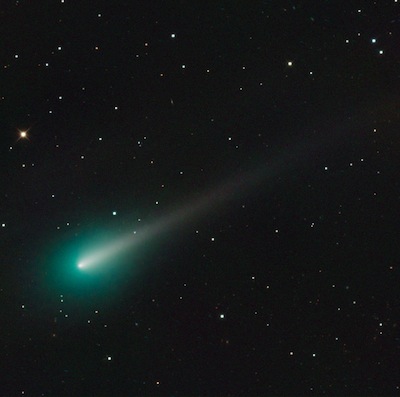
Comet ISON has good odds of enduring Sun encounter
BY STEPHEN CLARK
ASTRONOMY NOW
Posted: 17 October 2013

Comet ISON has a good chance of surviving its sizzling encounter with the Sun next month, meaning the much-hyped comet has a shot at putting on a brilliant sky show in the morning sky, according to a new study.

Comet ISON viewed on Oct. 8 through the 32-inch Schulman Telescope at Mount Lemmon, Ariz. Credit: Adam Block/Mount Lemmon SkyCenter/University of Arizona
Using a numerical simulation model, astronomers from Lowell Observatory and the Southwest Research Institute predict the comet is big enough and dense enough to withstand the heat and tidal forces during its swing by the Sun in late November.
Comet ISON, officially known as C/2012 S1, is barreling toward perihelion - its closest approach to the Sun - on November 28.
ISON will fall toward the Sun over the next few weeks, passing less than 1.2 million kilometers, or 750,000 miles, from the solar surface and confronting an environment that spells the end for many comets. When ISON races by the Sun at 377 kilometers per second, or 843,000 mph, it will see temperatures greater than 5,000 degrees Fahrenheit that can evaporate ice and extreme tidal forces capable of ripping rocks apart.
"We do predict from our investigation that comet ISON is likely to survive perihelion," said Matthew Knight, a research scientist at Lowell Observatory in Flagstaff, Arizona.
Knight said simulations he conducted with Kevin Walsh from the Southwest Research Institute show comet ISON can handle the perils of its encounter with the Sun. Knight and Walsh published the results of the NASA-funded study in Astrophysical Journal Letters, and the researchers discussed their work in an October 9 press conference at the American Astronomical Society's Division for Planetary Sciences meeting in Denver.
ISON is in a class of "Sungrazer" comets knocked into the inner solar system from the Oort cloud, a zone of icy objects estimated to reside up to a light-year away from the sun.
Knight said size and density estimates of ISON's nucleus, believed to be between 500 meters and 2 kilometers (1,640 feet to 1.2 miles) in diameter, indicate the comet should survive perihelion.
Jian-Yang Li, a researcher from the Planetary Science Institute, came up with a similar size estimate using observations with the Hubble Space Telescope. That makes ISON a rare breed of Sungrazing comets, which are typically much smaller.
ISON could be destroyed during the encounter, it could stay intact for a few days to several weeks before breaking apart, or it could complete its dash by the Sun intact.
It is plenty big to survive the threat from heat vaporizing the comet's reservoirs of ice, according to Knight. But scientists say predicting the effect of the sun's gravity on a Sungrazing comet is more difficult.
"When ISON gets close to the Sun, it can actually stretch it out and the gravitational pull can actually make it become like a cigar and become elongated," Knight said. "And if it's not strong enough, it can actually break apart into multiple pieces."
Lots of comets have disintegrated near the Sun, including the dazzling comet Lovejoy during its visit to the inner solar system in December 2011. Comet Lovejoy still managed enough brightness and a lengthy tail to be visible with the naked eye.
Based on constraints from observations of ISON and other comets, scientists say ISON should be dense enough to survive the tidal effects of the solar flyby.
Another key factor is the comet's direction and rate of rotation. Retrograde, or backward, spinners are more likely to withstand perihelion than comets that rotate in the opposite direction, scientists said.
There are scenarios where the Sun's gravity could break apart or destroy ISON, such as an unexpected increase in the comet's spin due to violent jets of gas triggered by solar heating.
"A major part of our work was to test if the encounter with the Sun would provide enough of a spin increase to pull material off the surface of the comet," Walsh said. "When the comet passes near the Sun, it feels the tidal forces pulling on it, and it also gets a slight spin increase due to this rapid flyby. This spin increase is in the prograde direction, so if the comet is already spinning prograde, then it's just that much closer to spinning fast enough to lose mass."
But odds are the comet will survive its brush with the Sun, and that is good news for skywatchers awaiting ISON's appearance in the morning sky.
The best viewing will come in December, after the comet's perihelion, when ISON will hang in the predawn sky. Knight and Walsh did not offer their estimates of its brightness, but many astronomers expect ISON will be readily visible with the naked eye.
"If it does survive, that gives us the best chance for observing it from the ground and, for this to become a naked eye comet," Knight said. "We would really like to see the nucleus survive until at least a few days after perihelion."
|



